General's rifle
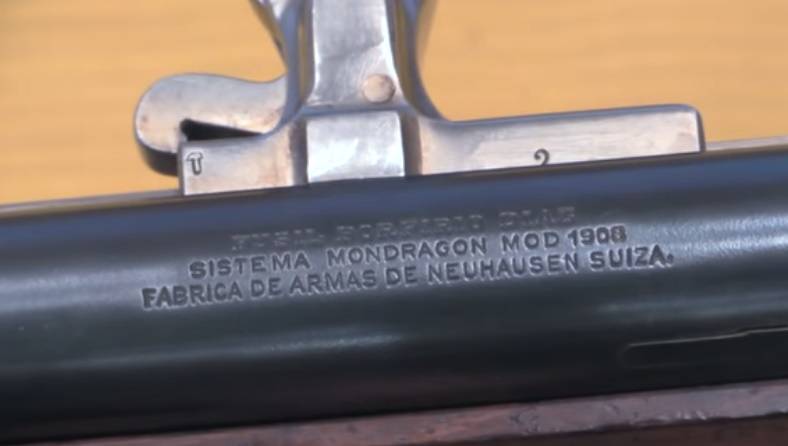
The rifle of General Mondragon was Mexican, but made in Switzerland, as this inscription says. Photo by Forgottenweapons.com
"Mexican" J. London
stories about weapons. It so happened that Mormon children became weapon designers, it happened that captains and colonels became them, both serving in the army and sometimes not serving (there were such!), but in stories there was also a gunsmith-general who designed first a cannon, and then a rifle - two rifles, first an ordinary bolt-action rifle, and the other an automatic one. And it would not be so surprising if it was a general from the States or some old state of Europe. But it was a Mexican general who designed his self-loading rifle at the very beginning of the XNUMXth century. His name was Manuel Mondragon.
He was born in Ixtlahuaca, Mexico City, in 1859, and died in San Sebastian, Spain, in 1922. As a teenager, he entered the Heroic Military College of Chapultepec, where he specialized as an artilleryman. After graduation, he worked in various military institutions, where he demonstrated the talent of a military engineer. He modified the French 75-mm gun, which allowed him to achieve high prestige in Mexican military circles. Moreover, this gun received his name and became known as "Saint-Chamond-Mondragon".
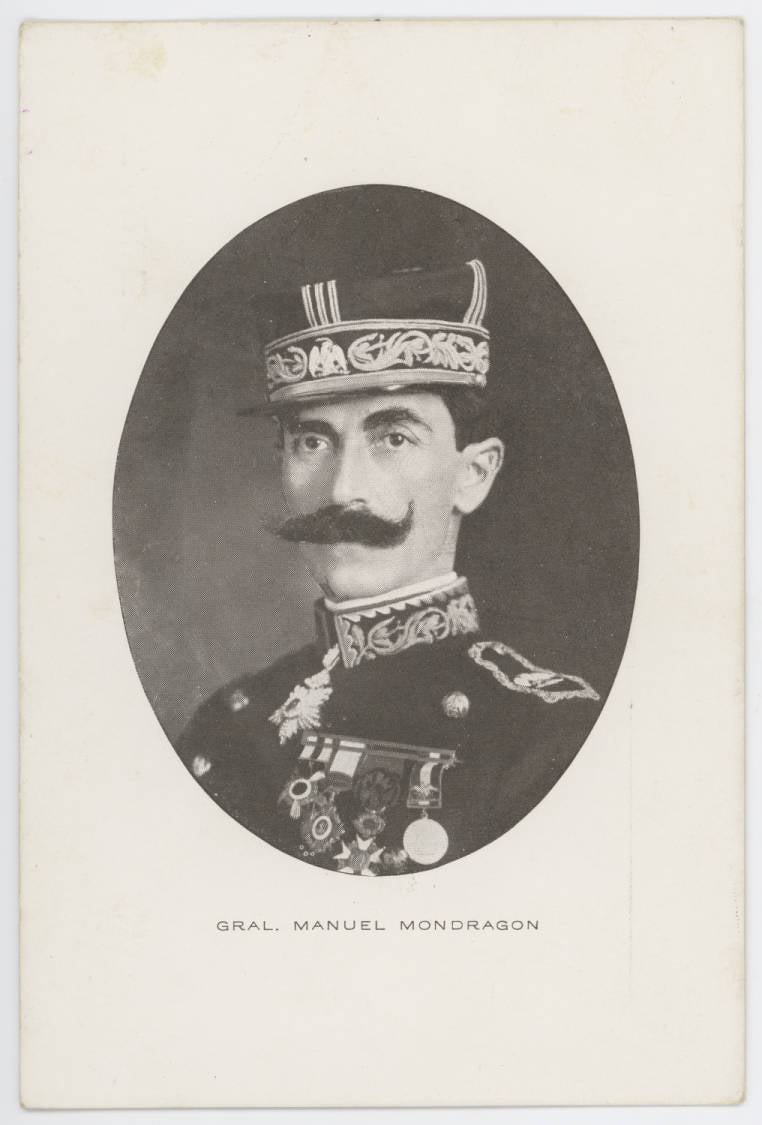
That's what a handsome man he was, Manuel Mondragon: all in orders and in sewing!
In 1904, Mondragon wrote the manual "Description and use of tools for the preparation and execution of a shot", and in 1910 "Description of a rapid-fire gun of 75 mm caliber". In 1907 he was appointed director of the Artillery Department. He drafted a new law on the army, based on compulsory military service, and, as a professor at the Military Academy, he also wrote the book "Defense of the Coasts" in 1910. Under his command was the artillery of the ports of Salina Cruz on the Pacific Ocean and Puerto Mexico (Coatzacoalcos) in the Gulf of Mexico.
In 1907, he patented a self-loading rifle that provided a rate of fire of up to 60 rounds per minute in semi-automatic mode. This was an important achievement, but the most interesting thing was that he managed to combine the work of a military designer and official with participation in the political life of the country.
So, on February 9, 1913, he took part in an uprising against President Francisco I. Madero in the capital of the country and released generals Bernardo Reyes and Felix Diaz, supporters of Porfirio Diaz, from prison. In the ten days that the confrontation between the forces loyal to Madero and those who opposed him lasted, hundreds of people died, great destruction, fires and looting took place in Mexico City, as a result of which the city was practically devastated. In the first battle, General Reyes was killed by machine gun fire, so Mondragon, along with Diaz, took command and barricaded themselves in the old building of La Ciutadella right in front of the presidential palace. President Madero instructed General Victoriano Huerta, who defended his government from Emiliano Zapata and Pascual Orozco, to fight the rebels, but he concluded a secret agreement with Diaz and Mondragon. Therefore, the president went to Cuernavaca to bring in the troops of General Felipe Ángeles loyal to him. And he, by the way, was the godson of Mondragon, with whom he, however, seriously quarreled. While he was gathering forces, on February 19, after shelling from La Ciutadella, the Mariana Gate of the National Palace collapsed. And on the same day, Mondragon became an accomplice to one of the most heinous crimes of this next military coup: the assassination of Gustavo Adolfo Madero, brother of President Francisco Madero, and at first he was blinded, and the execution of Mayor Adolfo Basso, who had previously surrendered to the rebels.
After the forced resignation of President Madero and his Vice President Jose Maria Pino Suarez, none other than Victoriano Huerta became president, under whom the formation of a new cabinet headed by Manuel Mondragón began. But the new government did not bring relief to the country.
A month after the military coup, an uprising began in the north of the country by one of the participants in the coup - Francisco Cardenas. Manuel Mondragon could do little under these conditions, and besides, he was always blamed for complicity in the murder of Gustavo Adolfo Modero. Because of these accusations, President Victoriano Huerta decided to expel him from the country, and he went to Spain, where ... he received the Order of the Legion of Honor from the French government. On November 26, 1919, he received the news that his godson, General Felipe Angeles, had been shot in Chihuahua by decision of a military tribunal. And, for sure, at the same time he thought that the same fate could have awaited him in his homeland.
Mondragon died of stomach tuberculosis in San Sebastian in September 1922, never returning to Mexico. His daughter Carmen, who did not accompany him in exile, became a well-known fashion designer. Other people involved in Madero's murder met tragic fates, starting with Victoriano Huerta (1916), Aureliano Blanca (1919), Francisco Cardenas (1920) and Félix Diaz (1945). But he nevertheless managed to develop a rifle named after him, and it was used during the First World War by both the Entente troops and the powers of the Triple Alliance.
The Model 1907 Mondragon Rifle was one of the first semi-automatic rifles officially adopted by the national army. He began working on it in 1891. Moreover, his work on it was encouraged by the future president of Mexico, Porfirio Diaz, who was very interested in all kinds of weapons and sought to raise the prestige of Mexico as the country that produced the first self-loading rifle in the world.

And this is the predecessor of a self-loading rifle: a rifle of the 1903 model with manual reloading. Photo httpsguns.fandom.com
However, Mondragon's first rifles were not automatic. These were ordinary bolt-action rifles chambered for 6,5 mm, the first sample of which was designed by him in 1893. They ordered it from the Swiss company SIG in Neuhausen, which supplied 50 rifles for testing in the Mexican army. The tests were successful enough that in 1894 another 200 of these rifles were ordered chambered for the improved and very unusual 5,2 x 68 mm cartridge. It was developed by Mondragon in collaboration with the Swiss Colonel Rubin (famous for his Schmidt-Rubin rifle) and was a very high pressure cartridge. Too high pressure to work well, as it turned out in practice.
This rifle had one interesting feature, interesting because it shows us the "zigzags" of the designs of the then designers. For example, Mondragon put three positions of the fire translator on the 1894 rifle at once. Two ordinary ones - "fuse" and "fire", but the third position was invented specifically for ... rapid fire. In this position of the translator, the drummer was released for an automatic strike on the primer, as soon as the shutter was completely closed. Thus, the shooter only had to move the bolt back and forth to fire, meaning this rifle fired while you were operating the bolt. It may be convenient to shoot from the hip like that, but what about aiming?
The Mondragon later returned to more conventional cartridges, with the Model 1903 being submitted to the British Army for trials chambered in the 7mm Mauser. The rifles were also chambered for Swiss 7,5mm and .30-30 Winchester cartridges.
The main contract for the supply of rifles to the Mexican army was concluded in 1908. According to him, she was supposed to receive 4000 7-mm Mauser rifles. Some of them, in order to win the favor of President Diaz, were inscribed "Fusil Porfirio Diaz, Systema Mondragon, Model 1908" (that is, "Porfirio Diaz Rifle, Mondragon System, Model 1908"). The first 400s were delivered in 1911 and were found (as SIG officials had warned) to tolerate poor quality ammunition very poorly. Much to SIG's dismay, the Mexican government decided to cancel the order after only 1000 rifles had been made, leaving SIG with 3000 rifles for which it was not paid.
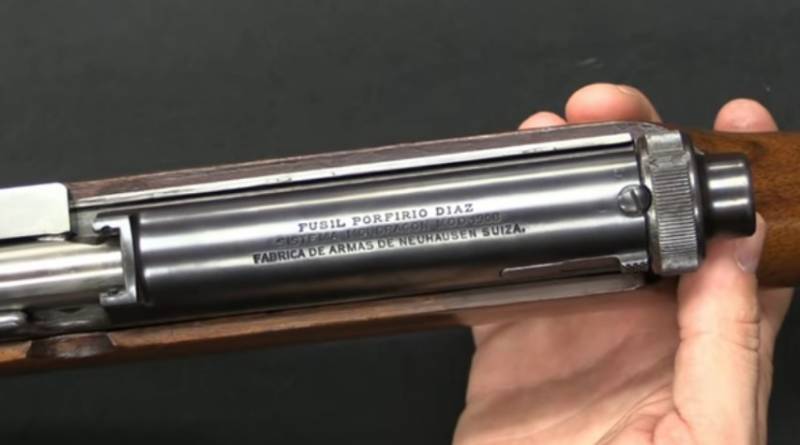
Here is the inscription on the bolt box. So that everyone, so to speak, knows that ... "our dear, beloved and adored President Porfirio Diaz" had a hand in its creation. Photo by Forgottenweapons.com
When the First World War broke out, the demand for military weapons became very large, and SIG found a buyer for the Mondragon rifles in the German Air Corps. It was adopted as the Flieger-Selbstlader-Karabiner 15 (self-loading aviation carbine, model 1915) as a temporary measure to give airborne observers a firearm that could be used effectively in flight.
To do this, they began to equip the rifle with a drum magazine for 30 rounds. The rifles required regular maintenance to keep them in working order, and their shooting accuracy was reported to be poor. Subsequently, they were replaced by more accurate, but even less reliable Mauser Selbstlader 1916 automatic rifles.
The 1908 Mondragon rifle had a gas piston located under the barrel. The shutter was rotating, and it turned due to two screw grooves on its body. They included two protrusions of the bolt frame, which moved along the cylindrical bolt box back and forth and at the same time turned the bolt. There were three locking lugs on the front of the bolt, and four more on the back. So the connection of the bolt to the barrel and bolt box was very strong.
One of the unusual features of the rifle is a lever switch located on the bolt handle that allows the shooter to disconnect the bolt from the gas piston rod. There were two benefits from this. The first was due to the fact that, by disconnecting the bolt carrier from the rod, it was possible to operate the bolt without much effort. The second, like the magazine cutoffs found on many early repeating rifles, was a nod to the military of the day, who wanted soldiers to not waste ammo in rapid fire. That is, so that it works like a conventional hand-operated rifle, but could switch to semi-automatic mode in emergency situations.
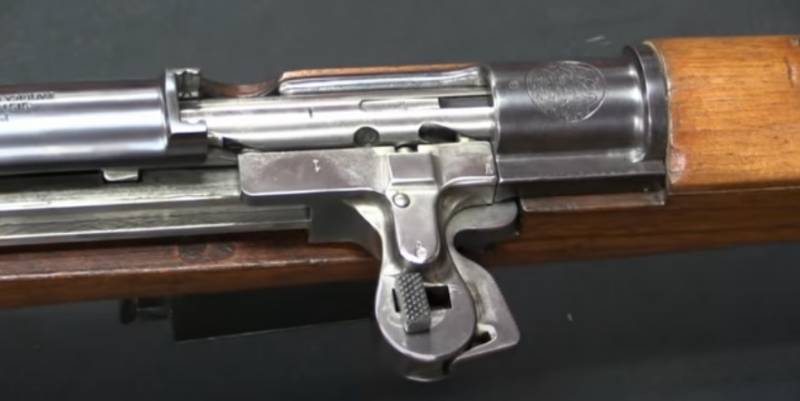
Look at this photo. It shows very well the corrugated key on the shutter handle, set across the hole located on it (and for it!) In this position, the lever protruding from the front of the handle will be locked and tightly connected to the gas piston, and with it the shutter. Photo by Forgottenweapons.com
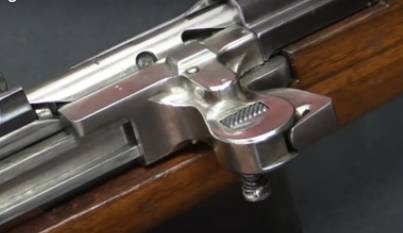
But in this position of the key (it was possible to lift it up by pressing on the spring-loaded spindle from below!) The lever, every time the handle moved back, disengaged from the gas piston rod. Photo by Forgottenweapons.com
To start shooting, it was necessary to pull the bolt back by pulling the handle. Since the shooter's hand at the same time pressed the lever on the handle, the bolt and the gas engine rod disengaged, and the automatic rifle no longer worked. So, without spending much effort, it was possible to move the shutter to the rearmost position. It was possible to insert a clip with cartridges into the grooves of the receiver and fill the magazine from above or insert an already filled one from below. After filling the store, the shutter should be moved forward by the handle. At this moment, the upper cartridge was sent into the chamber, and the bolt was engaged with the rod using a lever on the handle. Now you can pull the trigger and shoot! By the way, the safety on this rifle is located right in front of the trigger guard, which is certainly very convenient.
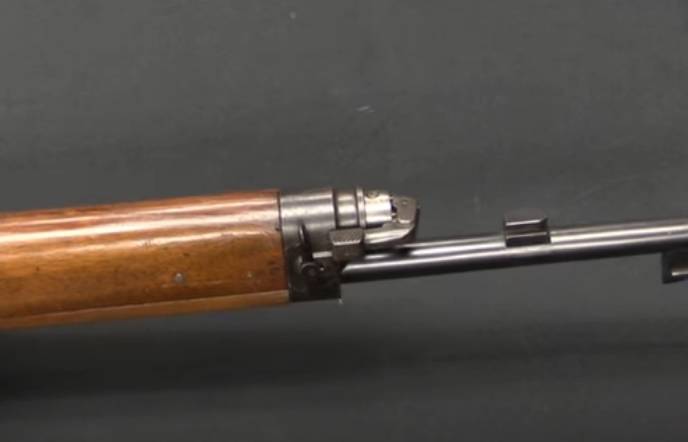
And yet - by the way, how thought out all the technical solutions were by the gunsmith general - the gas supply hole under the barrel could be blocked by turning this lever, and then the rifle turned from a self-loading rifle into a regular one ... Photo by Forgottenweapons.com
The rifle was fed with cartridges from a 6-round magazine. Moreover, when it was loaded, it could not be inserted completely, and then shoot from a rifle, as from a single-shot one, but it was possible to push it all the way and then fire automatically.
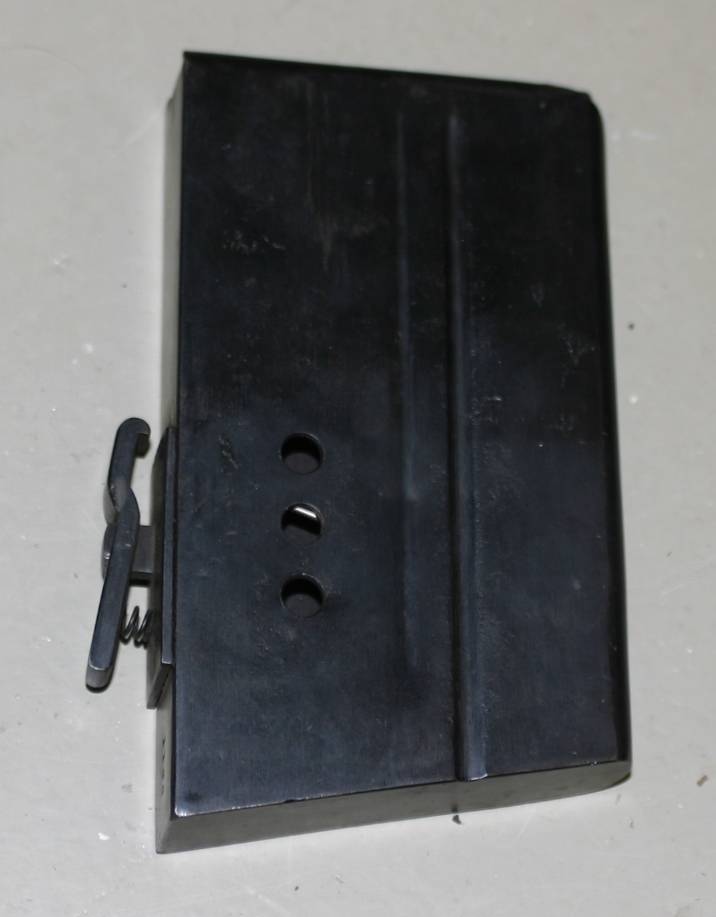
Store appearance. Photo https://www.rockislandauction.com
The magazine latch was located on itself in the back of the case. Some variants used 20-round box magazines in addition to the German 30-round drum magazine. The rifle had a sight with markings from 300 to 2000 yards and was completed with a frightening-looking shovel bayonet.
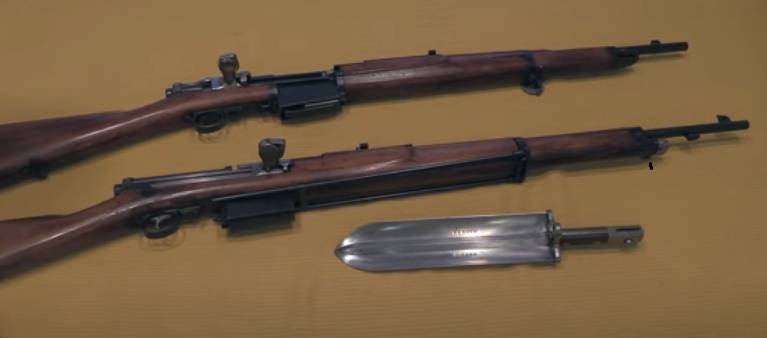
Here it is, this bayonet on the lower right. Above the M1904 rifle, below the M1908. Some rifles also had bipods for automatic fire from a stop. Photo by Forgottenweapons.com

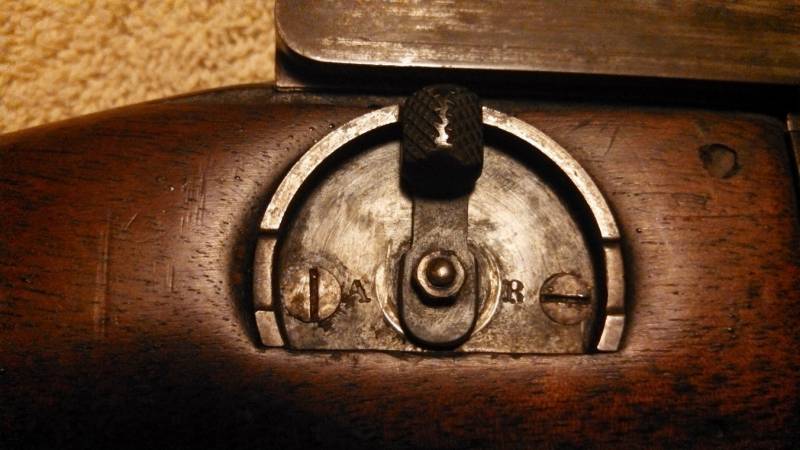

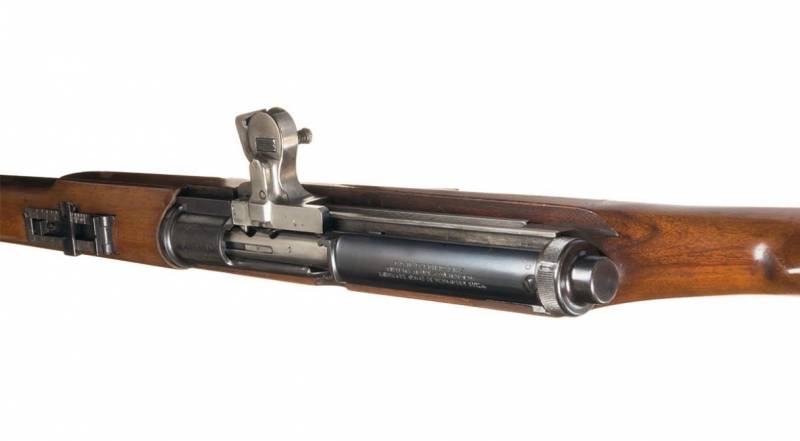
Information